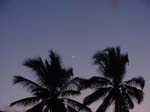 At
the beginning of Ramadhan, I met Birgit in Dar and we travelled
down the Swahili Coast for a pleasant 2 weeks "away from it
all". The original plan was to cross into Mozambique from
Tanzania by land, but unfortunately my visa didn't materialise
in time from the consulate's office here in Zanzibar – and
then it was too late to wait for it to be issued in Dar. At
the beginning of Ramadhan, I met Birgit in Dar and we travelled
down the Swahili Coast for a pleasant 2 weeks "away from it
all". The original plan was to cross into Mozambique from
Tanzania by land, but unfortunately my visa didn't materialise
in time from the consulate's office here in Zanzibar – and
then it was too late to wait for it to be issued in Dar.
In Mtwara we asked everybody who might know what the chances
were of entering Mozambique without a visa but in the end I decided
they were pretty slim. It certainly would have been an adventure
to exit Tanzania (cancelling Birgit's single entry visa), get
local transport to the river crossing. 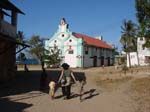 Wait
for high-tide to cross. Find further transport 7km up to the
Moz immigration post. Show my note from the Moz Consulate (ZNZ)
explaining that it wasn't my fault and smiling sweetly. The consequence
of being refused and having to back-track sounded like too much
pain and possibly take too much time… especially as the
fallback plan was to get a flight the following day. So instead,
we had a lovely slap-up lunch at the Southern Cross hotel overlooking
the bay and a second night at "10 degrees south" in
the pretty fishing village of Mikindani. Wait
for high-tide to cross. Find further transport 7km up to the
Moz immigration post. Show my note from the Moz Consulate (ZNZ)
explaining that it wasn't my fault and smiling sweetly. The consequence
of being refused and having to back-track sounded like too much
pain and possibly take too much time… especially as the
fallback plan was to get a flight the following day. So instead,
we had a lovely slap-up lunch at the Southern Cross hotel overlooking
the bay and a second night at "10 degrees south" in
the pretty fishing village of Mikindani.
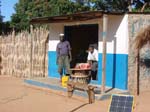 I
found Pemba (Moz) big, functional, with an interesting historic
quarter and a gorgeous 5km beach looking a little like a resort
somewhere along the Mediterranean from 50 years ago. Arriving by
air, not only saved a few dollars on the price of the visa, but
it meant we could start our travels from a town with cash machines,
telephone cards and a variety of bread and vegetables which I think
we didn't really appreciate till we'd been "up country"
for a week. I
found Pemba (Moz) big, functional, with an interesting historic
quarter and a gorgeous 5km beach looking a little like a resort
somewhere along the Mediterranean from 50 years ago. Arriving by
air, not only saved a few dollars on the price of the visa, but
it meant we could start our travels from a town with cash machines,
telephone cards and a variety of bread and vegetables which I think
we didn't really appreciate till we'd been "up country"
for a week.
The province of Cabo Delgado was most rewarding to visit. Away
from any tourist trimmings we travelled by lorry along dirt-track
roads, stopping frequently to drop and pick and occasionally stretch
our legs. The land was undulating and fertile. People looked well
fed and well clothed. 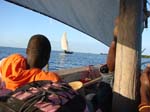 One
cultural curiosity is seeing women and daughters going about their
everyday activities wearing a white face-pack. Very exciting at
first, but I think eventually even the photographer in me managed
to get over it. One
cultural curiosity is seeing women and daughters going about their
everyday activities wearing a white face-pack. Very exciting at
first, but I think eventually even the photographer in me managed
to get over it.
At the end of the road we waited under the meagre midday shade
of a cashew tree among the mangroves and mudflats waiting for the
tide to come in sufficiently to take a dhow across to the island
of Ibo. 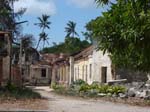 A
former Portuguese administrative centre, the "town" was
laid out with broad tree lined avenues, colonnaded street, paved
squares, fortresses, a church and a number of elegant municipal
buildings. The present population live among and beyond in their
own mud-walled, grass roofed houses. At night, once the new moon
has set, the island is still, quiet and in pitch blackness. There's
no electricity. The stars are fantastic. A
former Portuguese administrative centre, the "town" was
laid out with broad tree lined avenues, colonnaded street, paved
squares, fortresses, a church and a number of elegant municipal
buildings. The present population live among and beyond in their
own mud-walled, grass roofed houses. At night, once the new moon
has set, the island is still, quiet and in pitch blackness. There's
no electricity. The stars are fantastic.
A couple of days later we continued our travels by dhow, moving
along the coast, past beautiful "desert" islands and
one up-market (presumably South African) island resort; the water
a beautiful clear turquoise green. The wind was not always favourable,
and at one point we realised the bay we had entered was too shallow
to cross and the boatmen had to punt our way back out to the open
sea. 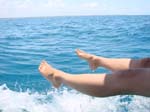 It
was during this heightened activity that a freak wave dowsed our
luggage and "half-filled" our boat. We recovered, damp
but otherwise unscathed, feeling extremely vulnerable for the following
hour. It
was during this heightened activity that a freak wave dowsed our
luggage and "half-filled" our boat. We recovered, damp
but otherwise unscathed, feeling extremely vulnerable for the following
hour.
We stayed the following weekend in a fishing village called Pangane,
located on a spit of land and so boasting a choice of beaches and
swimming. 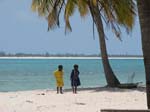 The
guest house featured a fish wholesaler's walk in refrigerator which
meant there was a good supply of seafood for supper and the beers
were well chilled. The
guest house featured a fish wholesaler's walk in refrigerator which
meant there was a good supply of seafood for supper and the beers
were well chilled.
It seems wherever you go by public transport in Mozambique, reporting
time is always 4am – about 45mins before first light. So
on the Monday morning we stood silently, gazing at Orion and Sirius,
waiting for the murmur of a distant motor vehicle. We were headed
400km south and expected to do it in a minimum of 3 stages, ideally
in the same day. Of course when the lorry came it already had a
mountain of people on board. Why didn't anyone mention that Mondays
is post-natal day at the bush hospital 40km up the road?
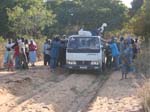 The
lorry picked its way along a bumpy dirt track, the bush brushing
sometimes dangerously at our dangling legs. The sun came up and
"the craic was good" (as Van the man would say). In one
section the track became too sandy and everyone had to get off –
the able men helping to push. We ended-up walking about a kilometre
through the bush. The
lorry picked its way along a bumpy dirt track, the bush brushing
sometimes dangerously at our dangling legs. The sun came up and
"the craic was good" (as Van the man would say). In one
section the track became too sandy and everyone had to get off –
the able men helping to push. We ended-up walking about a kilometre
through the bush.
Fifty seven kilometres and several hours later we reached the
junction with the "motor road" – the main trans-national
highway. Luckily an "interstate" bus came through shortly
after so by 8:20am we had started the second segment, albeit standing
on a very crowded bus. A further 8 hours and the final connection
was made with similar ease, though Birgit complained there had
been no time for a "comfort break". (I was nervous that
we still had more journey than daylight ahead of us.)
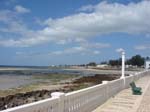 It
may have been downhill to the coast but I suspect our increasing
momentum was due more to our driver wanting to break his Ramadhan
fast. Increasingly we dropped passengers in haste and refused to
stop for others. At the end of the road we screeched into the market
and sacks of grain were frantically unloaded. I was amazed (sorry
no photo) to see among the normal fast food enticements on offer
was a tray of snails in garlic – yes really! I don't recall
ever seeing this in Africa before, in fact anywhere. There were
two sizes, the larger shells (10cm) I'm pretty sure were land-based,
but the smaller ones looked just like what I had once had in Paris. It
may have been downhill to the coast but I suspect our increasing
momentum was due more to our driver wanting to break his Ramadhan
fast. Increasingly we dropped passengers in haste and refused to
stop for others. At the end of the road we screeched into the market
and sacks of grain were frantically unloaded. I was amazed (sorry
no photo) to see among the normal fast food enticements on offer
was a tray of snails in garlic – yes really! I don't recall
ever seeing this in Africa before, in fact anywhere. There were
two sizes, the larger shells (10cm) I'm pretty sure were land-based,
but the smaller ones looked just like what I had once had in Paris.
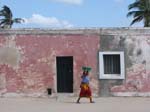 By
the time we turned out of the market and on to the raised single-track
causeway, the sun had surely set. At the other end, lying several
kilometres out to sea, was Ilha do Moçiambique; streetlights
shining. Our chosen guesthouse was an old stone building with high
ceilings, sea-view bedrooms and a comfortable living room. I immediately
felt "at home" and was quite happy that this should be
our base for the next 3 or 4 nights. By
the time we turned out of the market and on to the raised single-track
causeway, the sun had surely set. At the other end, lying several
kilometres out to sea, was Ilha do Moçiambique; streetlights
shining. Our chosen guesthouse was an old stone building with high
ceilings, sea-view bedrooms and a comfortable living room. I immediately
felt "at home" and was quite happy that this should be
our base for the next 3 or 4 nights.
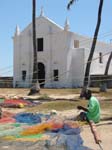 Ilha
felt good, though it's hard to say exactly why. Clearly it had
been significant in Portuguese times; the fortresses, the churches,
the public buildings and merchants' houses. Generally the streets
were broad enough for vehicles and the architecture predominantly
colonial. There were paved squares with park benches, and even
an esplanade with ornamental lighting. And yet there was something
Swahili about it too, I found it curiously reminiscent of Zanzibar,
or even Lamu, possibly from an era before tourism has staked its
claim. Ilha
felt good, though it's hard to say exactly why. Clearly it had
been significant in Portuguese times; the fortresses, the churches,
the public buildings and merchants' houses. Generally the streets
were broad enough for vehicles and the architecture predominantly
colonial. There were paved squares with park benches, and even
an esplanade with ornamental lighting. And yet there was something
Swahili about it too, I found it curiously reminiscent of Zanzibar,
or even Lamu, possibly from an era before tourism has staked its
claim.
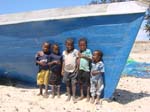 We
had some nice lazy days there, exploring, reading, eating out and
chatting to people. One day I bought some sardines on the beach
and we had a lovely long lazy lunch "at home" over a
bottle of vinho verde. We
had some nice lazy days there, exploring, reading, eating out and
chatting to people. One day I bought some sardines on the beach
and we had a lovely long lazy lunch "at home" over a
bottle of vinho verde.
|